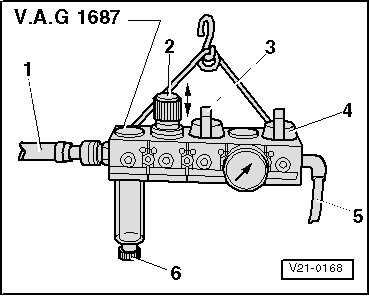| Checking tightness (inside) |

Note | After re-installing an already used tandem pump e.g. after changing or repairing a cylinder head and/or after changing an engine without component parts, the tandem pump must be checked for internal tightness between fuel and oil part. In case of leakage fuel and oil can be mixed, which can cause an engine damage. |
| Special tools and workshop equipment required |
| t
| Tester (e. g. -V.A.G 1687-) |
| –
| Disconnect the fuel feed hose (white marking) and the fuel return hose (blue marking) from the tandem pump. |
| –
| Close fuel return-flow connection at tandem pump with a plug. Secure plugs with spring strap clips. |
| Prepare tester -V.A.G 1687- as follows: |
|
|
|
 Note
Note Note
Note Note
Note

 Note
Note Note
Note Note
Note
